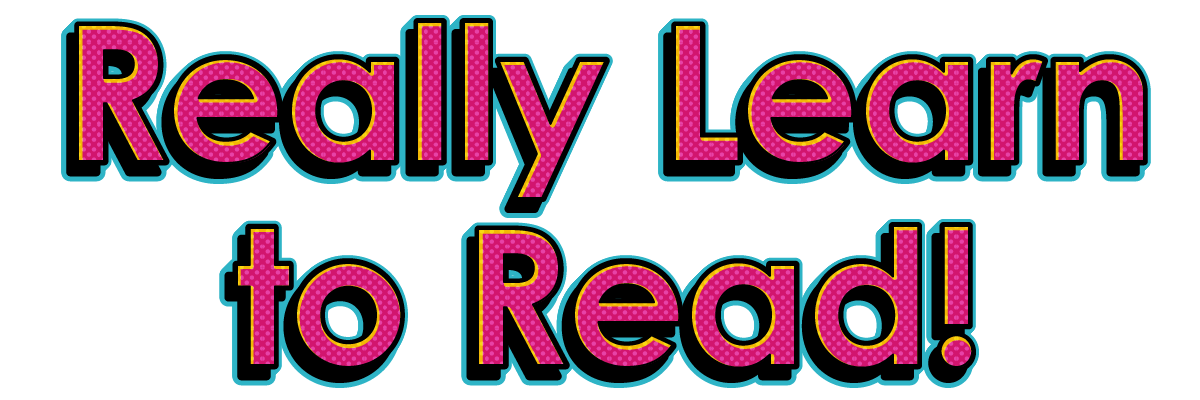Long a – Book 1 of 5
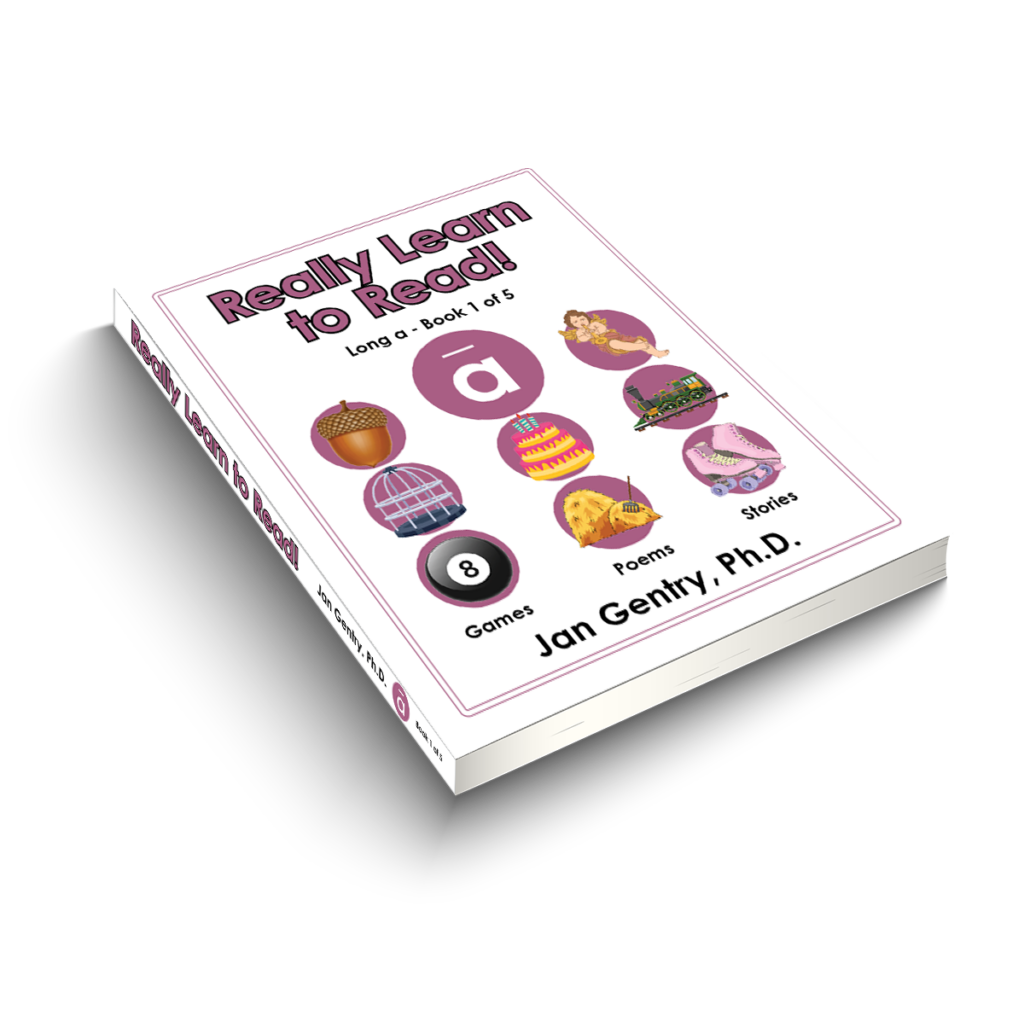
This first workbook in the Long Vowels Series is designed to continue the love for reading in a simple English learning format. Long a is compiled of a variety of phonics lessons specifically for children, teenagers, and adults on Grades 1-2 reading levels. With vibrant graphics combined with poems and stories, readers are challenged to make long a words, learn new sight words, answer questions, and interact with various activity sections. Upon completing Book 1, learners are becoming equipped with essential decoding skills and have begun to attain literal comprehension of the facts, vocabulary, ideas, and information directly stated in the text.
Student Edition
Make Words
Each lesson begins with learners combining the selection of beginning consonants (onsets) with lists of long a rhyming word families (rimes). The onsets are written next to the rimes if the reader determines that the sounds are real words. This is a fun game as learners write as many words as they can with these smallest units of sounds. Self-confidence grows as they recognize the same long a spelling patterns in other words, transfer the sounds, and successfully read the new words. This phonetic transfer ability increases reading fluency which is vital for enabling readers to focus on their comprehension, rather than on decoding each word.
Goofy Poems
In this second activity, learners are introduced to new sight words in a dotted box, followed by reading four poems that give review in reading the sight words and various long a words from Make Words. While the poems are silly, they give valuable practice in reading words “on sight” and in decoding the different long a word families. Additional long a rhyming words not listed in Make Words are underlined in the poems to promote recognition of word family patterns, transfer of sounds, and success in reading new words. These skills generate fluency in word recognition and boost reading confidence.

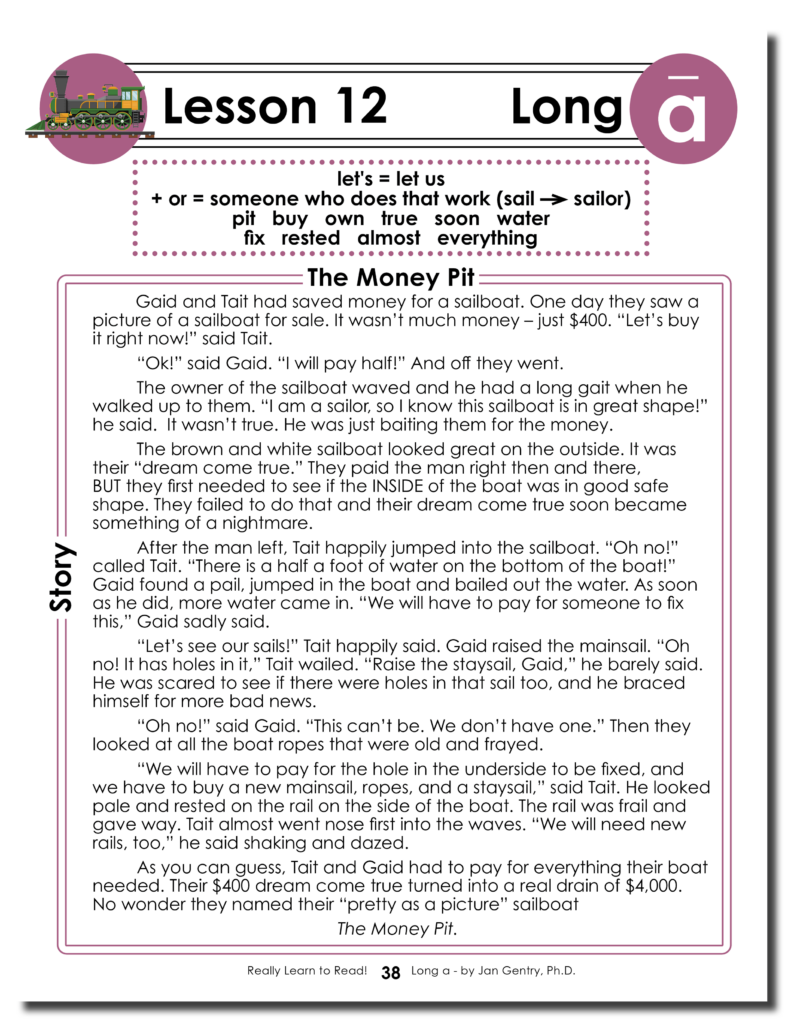
Story
Readers are given new sight words, followed by reading funny stories and interesting stories based on true facts. The engaging stories present enjoyable practice in reading the sight words and long a words from Make Words. As the reader becomes more familiar with these words, reading fluency emerges and is reinforced. Stories also give practice with meanings of inflected endings, contractions, prefixes, suffixes, and compounds words. With the help of these fun and engaging stories, readers progress through Grades 1-2 reading levels, comfortably gaining experience with phonics skills, expanding their vocabulary range, and developing their comprehension skills with self-confidence.
Question & Answer
After each poem and story, learners are involved in various activities designed to reinforce the skills just learned. The activities and questions format includes true and false, short answer, matching, fill in the blank, and multiple choice. This section encourages readers to understand the text, recall details, acquire new vocabulary, draw conclusions, use references, and evaluate to make judgment. Readers interact with text as they give specific answers to questions or activities that often begin with “what, where, who, when, and how.” These questions improve the reader’s knowledge, understanding, and memory of what was just read. Additionally, learners are given practice in spelling, a valuable skill that supports learning to read and deepens understanding of the English language.
Draw a Picture
After completing the Question & Answer section, a picture box with directions on what to draw provides a fun and colorful activity. It is also a significant exercise in that readers create mind pictures as they read. Their drawings reflect comprehension of the characters, setting, themes, or details from the story. The picture box directions stir recall of the mind pictures, and encourage imagination and creativity.
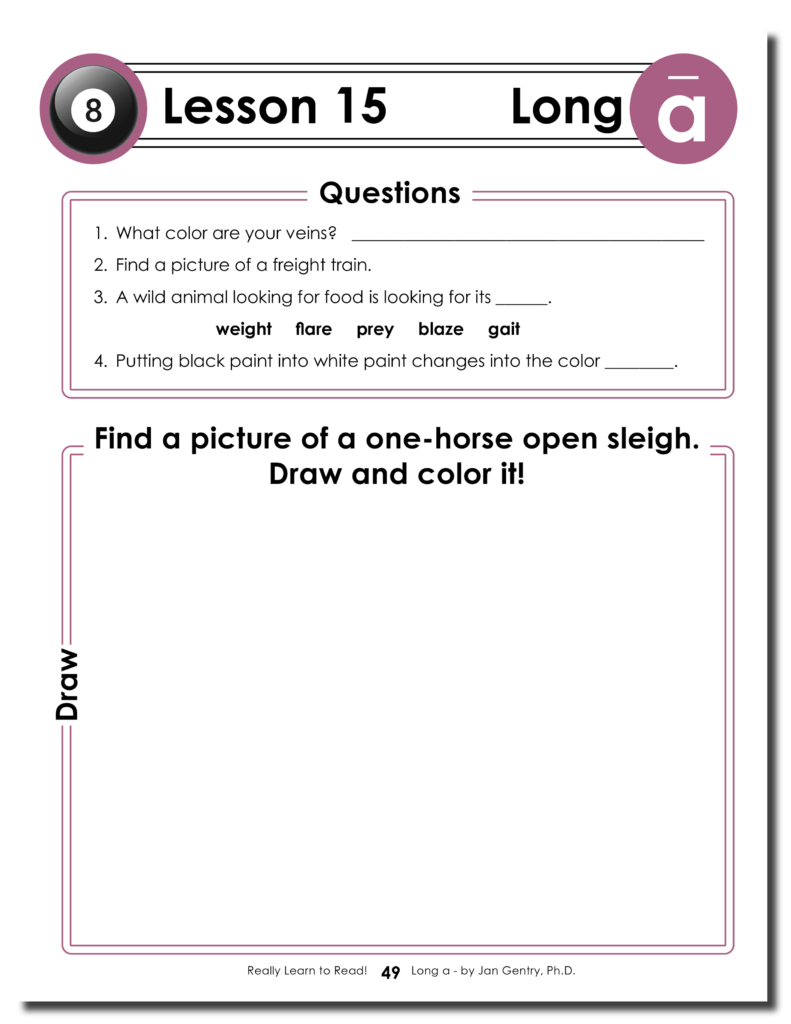
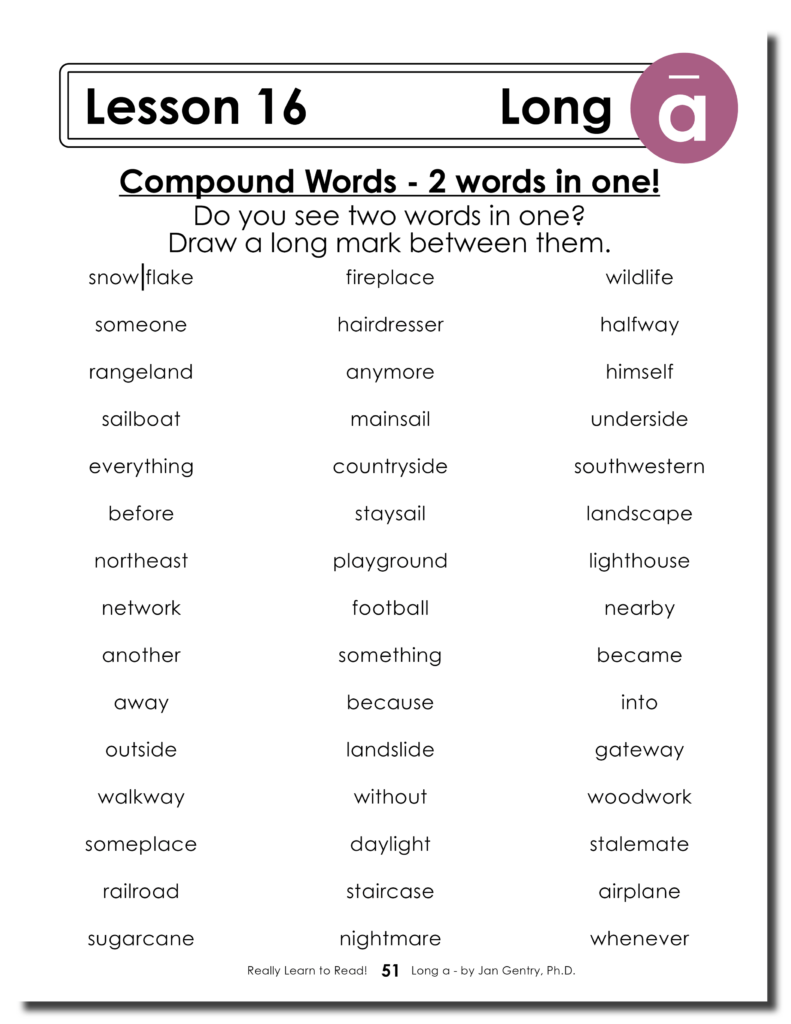
Compound Words
A fun activity at the end of the Long a workbook is recognizing two words in one and drawing a line between them. When two nouns are combined, the new compound word has its own different meaning. This awareness encourages learners to find other compound words or creatively combine two nouns on their own. Compound words enhance vocabulary and expand language proficiency as learners later encounter longer words to read and spell.
Identifying Antonyms
The final fun reading activity is the matching of opposite words. Awareness of antonyms improves critical thinking skills, strengthens comprehension, and enhances vocabulary knowledge. This hands-on activity of drawing a line from one word to its opposite helps learners by building background knowledge, determining word associations, grasping multiple word meanings, and reinforcing spelling accuracy.
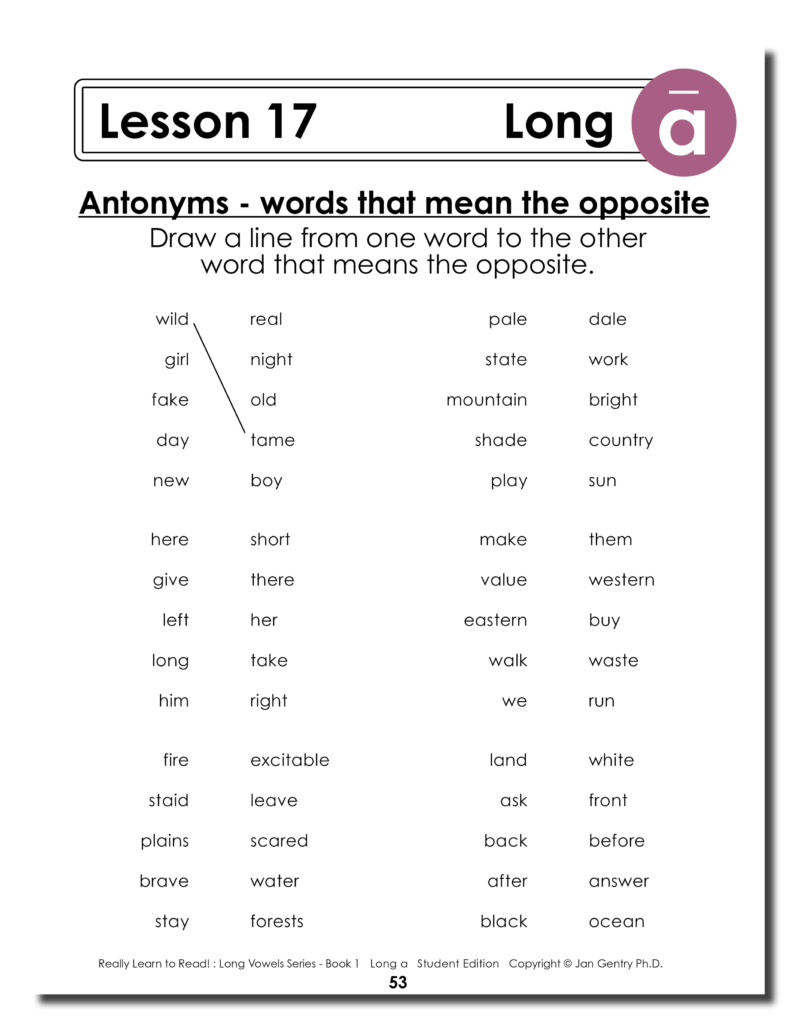
Teacher Edition

In addition to the Long a – Book 1 for the student, the Teacher Edition book includes:
- Answers to questions and activities in each lesson, written in red for easy recognition
- Phonics and Decoding Skills listed in specific detail for each lesson
- Reading Comprehension Skills listed for each question in the poems and stories
- Quick Reference Guide to help quickly target specific areas of attention
This edition provides the reading instructor with a thorough, systematic, well-defined, and successful phonics curriculum.
Answers
The Long a Teacher Edition is the same as the student’s copy, with the addition of easy to read answers in red print for all questions and activities in each lesson. The various activity sections facilitate identification and evaluation of a student’s strengths and weaknesses in reading, vocabulary, and spelling skills. For some questions and activities, there are motivating ideas, creative suggestions, and multiple answers provided for positive reinforcement to student responses that are different, opinionated, creative, and correct.


Phonics and Decoding Skills
The Phonics and Decoding Skills section provides teachers with an easy, convenient, detailed list of all reading, vocabulary, and other literacy skills in each lesson: long a word family endings (rimes), beginning consonants (onsets), inflected endings, prefixes and suffixes, contractions, compound words, abbreviations, cardinal and ordinal numbers, fractions, dates, idioms, word symbols, long a word families, and sight words. This condensed format gives teachers the convenience of quickly reviewing each lesson for determining the skills the learner has mastered or that require additional practice for reading success.
Reading Comprehension Skills
The Reading Comprehension Skills section serves as a valuable reference tool for teachers to trace each question and activity in each lesson to its specific skill objective. Objectives include details, vocabulary, drawing conclusions, critical thinking, real life application, using references, using prior knowledge, and evaluating to make judgment. Referring to this table format, teachers can easily monitor the categories of comprehension skills that are developing, needing practice, or being mastered as the reader progresses through Grades 1 and 2.
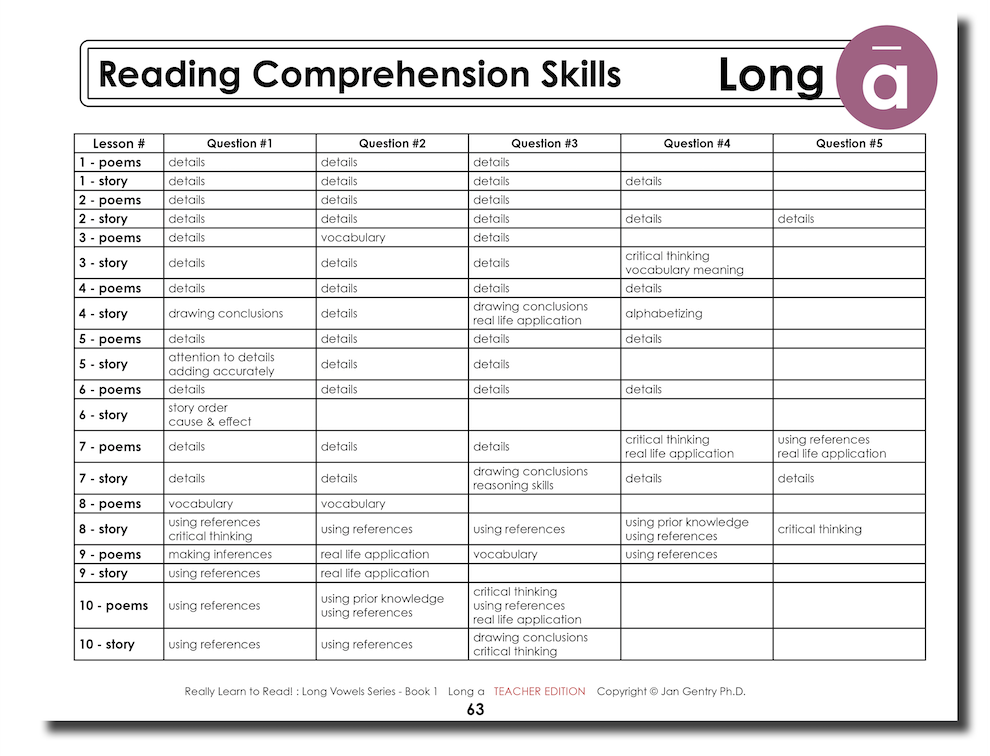

Quick Reference Guide
The Quick Reference Guide provides teachers with immediate identification of skills in each lesson. Skill categories include rimes and onsets, inflections, prefixes and suffixes, contractions, compounds, abbreviations, dates and numbers, idioms, and word symbols. This guide is ideal for highlighting skills to be learned, as well as to note those skills requiring review and practice.
Order Today
Each book is available individually, or as a set with the other books in its series. You can choose Paperback or Portable Document Format (PDF) versions. The convenient PDF allows immediate download so teachers can tailor lessons to their students’ needs by printing specific sections at a time. A Teacher Edition is also available (PDF Only) to provide the reading instructor with a carefully designed, systematic, true phonics-based curriculum.
